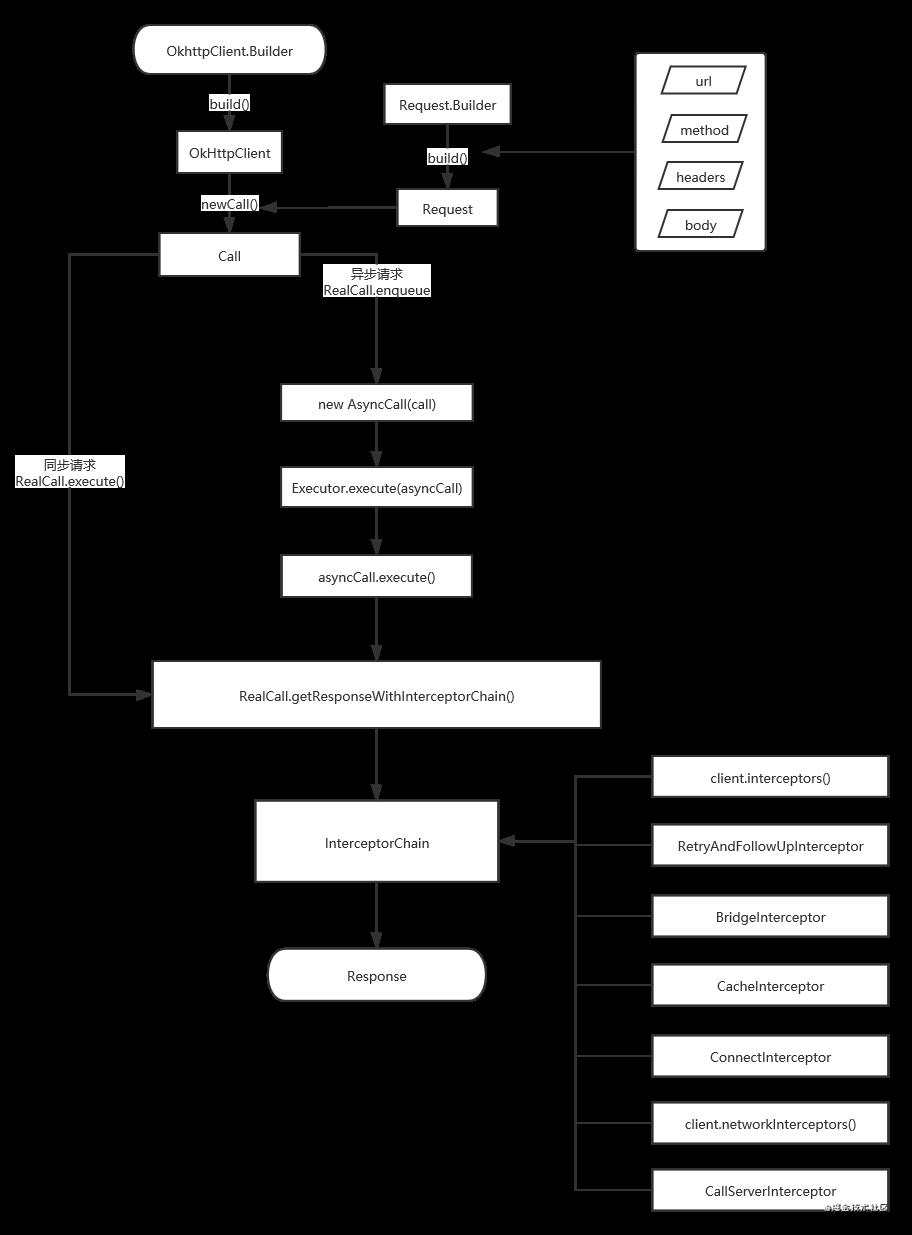揭秘Android常用三方框架源码-okhttp
Posted 码农 小生
tags:
篇首语:本文由小常识网(cha138.com)小编为大家整理,主要介绍了揭秘Android常用三方框架源码-okhttp相关的知识,希望对你有一定的参考价值。

okhttp是一个处理网络请求的开源项目,是安卓端最火热的轻量级框架,由移动支付Square公司贡献(该公司还贡献了Picasso) 用于替代HttpUrlConnection和Apache HttpClient。作为常用框架,无论是从使用还是面试方面,我们都有必要了解其源码实现,不能仅停留在api的调用层面。
在讲解其源码之前,先来简单回顾一下okhttp的使用。
一、基本使用
1.1 导入
通过gradle引入依赖
implementation 'com.squareup.okhttp3:okhttp:3.14.0'
implementation 'com.squareup.okio:okio:2.8.0'
okhttp目前最新可用版本为4.9.1,位于maven中心仓库,使用kotlin语言编写,本篇文章以公司某个项目所用版本进行分析,为java语言。
1.2 使用
//同步请求,需放在子线程
lifecycleScope.launch {
withContext(Dispatchers.IO) {
val syncCall =
OkHttpClient().newCall(Request.Builder().url("https://www.baidu.com/").get().build()).execute()
toast("sync call result is ${syncCall.body()?.string()}")
}
}
//异步请求
OkHttpClient().newCall(Request.Builder().url("https://www.baidu.com/").get().build())
.enqueue(object : Callback {
override fun onFailure(call: Call, e: IOException) {
}
override fun onResponse(call: Call, response: Response) {
toast("sync call result is ${response.body()?.string()}")
}
})
通过上面代码,我们就能以最快速度使用okhttp(代码中toast为项目中扩展出来的方法,当做原生toast的使用即可)。
二、源码中关键类
2.1 OkHttpClient
用于发送http请求并读取其响应,调用newcall()创建call对象,对于一个项目来说,okhttpclient应该以单例模式提供实例,通过复用连接池和线程池减少延迟并节省内存,使okhttp性能最佳。
okhttpclient采用构建者模式创建实例的同时,为其属性赋值。
- 通过OkHttpClient()获取实例采用默认设置
- 通过new OkHttpClient.Builder()获取实例时可以自定义配置(连接超时、读取超时、写入超时、拦截器、缓存信息等)
关于构建者模式,我们在平常开发中也可以使用,比如封装页面titleBar时,标题栏左、中、右三个区域即可指定文本、又可指定图片、或者文本图片混合,以及三个区域各个元素左上右下间距、文本大小、样式、点击事件等等。通过构建者模式,可以将大量的属性聚合在一起,通过链式调用设置属性,将调用与实现分离,既美观又便于维护。
2.2 Request
一个request就代表一个Http请求,内部封装了url、请求方式、请求头、请求体等信息,也是通过构建者模式创建。
2.3 Call
一个call代表一个准备好要执行的request,可以被取消掉,不能被多次执行。其实现类为RealCall,call提供同步调用方法execute()、异步调用方法enqueue(Callback responseCallback)。
2.4 AsyncCall
AsyncCall是RealCall的内部类,是NamedRunnable接口的实现类,我们只要知道它是一个Runnable类型的实现类即可,异步请求的处理实际由该类的executeOn()方法完成。
2.5 Dispatcher
调度请求的类,内部有最大请求数(默认64)、每个主机最大请求数(默认5)、线程池、三个双端队列(准备执行的异步队列readyAsyncCalls、正在执行的异步队列runningAsyncCalls、正在执行的同步队列runningSyncCalls)等属性。
关于线程池,其实现如下:
Dispatcher.java
public synchronized ExecutorService executorService() {
if (executorService == null) {
executorService = new ThreadPoolExecutor(0, Integer.MAX_VALUE, 60, TimeUnit.SECONDS,
new SynchronousQueue<>(), Util.threadFactory("OkHttp Dispatcher", false));
}
return executorService;
}
- 核心线程数量corePoolSize = 0
- 最大线程数量maximumPoolSize = Integer.MAX_VALUE,即线程数量几乎无限制
- keepAliveTime = 60s,线程空闲60s后自动结束。
- workQueue为SynchronousQueue 同步队列,这个队列类似于一个接力棒,入队出队必须同时传递,因为线程创建无限制,不会有队列等待,所以使用SynchronousQueue。
关于双端队列Deque(double ended queue):
可以作为FIFO(First In First Out)的queue,也可以当做LIFO(Last In First Out)的stack使用,push和pop方法只在stack的形式下可以使用。不像list一样,双端队列不支持根据索引获取元素。
其常用api总结如下:
- boolean add(E e):在尾部添加元素,如果队列有数量限制,超出数量添加抛出IllegalStateException
- boolean offer(E e):在尾部添加元素,如果队列有数量限制,超出数量返回false,不抛异常
- E remove():检索并移除队列头部元素,如果队列为空,抛出NoSuchElementException
- E poll():检索并移除队列头部元素,如果队列为空,返回null,不抛异常
- E element():检索不移除队列头部元素,如果队列为空,抛出NoSuchElementException
- E peek():检索不移除队列头部元素,如果队列为空,返回null,不抛出异常
- void push(E e):将元素压入双端队列代表的栈中(队列头部,栈专用方法),如果队列有数量限制,超出数量添加抛出IllegalStateException
- E pop():从此双端队列代表的堆栈中弹出一个元素(移除并返回队列头部,栈专用方法),如果队列为空,抛出NoSuchElementException
三、源码分析
3.1 同步请求方式分析
同步请求由execute()方法开始,先看一下RealCall的execute()实现
RealCall.java
@Override public Response execute() throws IOException {
synchronized (this) {
if (executed) throw new IllegalStateException("Already Executed");
executed = true;
}
transmitter.timeoutEnter();//开始超时计算
transmitter.callStart();//请求开始
try {
client.dispatcher().executed(this);//执行请求
return getResponseWithInterceptorChain();//获取响应
} finally {
client.dispatcher().finished(this);//请求完成
}
}
其中,执行请求的方法实现如下:
Dispatcher.java
/** Used by {@code Call#execute} to signal it is in-flight. */
synchronized void executed(RealCall call) {
runningSyncCalls.add(call);
}
就是把当前的同步请求call放入了Dispatcher的runningSyncCalls中。
看下请求完成的方法实现:
Dispatcher.java
/** Used by {@code Call#execute} to signal completion. */
void finished(RealCall call) {
finished(runningSyncCalls, call);//
}
private <T> void finished(Deque<T> calls, T call) {
Runnable idleCallback;
synchronized (this) {
//移除请求
if (!calls.remove(call)) throw new AssertionError("Call wasn't in-flight!");
idleCallback = this.idleCallback;
}
boolean isRunning = promoteAndExecute();//检查是否存在正在执行的请求
if (!isRunning && idleCallback != null) {//不存在正在执行的请求且空置回调不为空
idleCallback.run();
}
}
把该请求从同步请求队列runningSyncCalls中移除。如此看来,对同步请求的处理就发生在了RealCall$getResponseWithInterceptorChain()中。
总结一下:
调用execute()进行同步请求时大致分三步:
- 请求加入runningSyncCalls队列
- RealCall$getResponseWithInterceptorChain()调用
- 请求从runningSyncCalls队列移除
关于getResponseWithInterceptorChain()的分析后面会讲。
3.2 异步请求方式分析
异步请求由enqueue(CallBack callBack)方法开始,看一下RealCall的enqueue(CallBack callBack)后会执行哪些操作
RealCall.java
Override public void enqueue(Callback responseCallback) {
synchronized (this) {
if (executed) throw new IllegalStateException("Already Executed");
executed = true;//标识正在执行
}
transmitter.callStart();
client.dispatcher().enqueue(new AsyncCall(responseCallback));
}
调用enqueue后,会用我们创建的响应回调生成一个AsyncCall,并且调用Dispatcher的enqueue()
Dispatcher.java
void enqueue(AsyncCall call) {
synchronized (this) {
readyAsyncCalls.add(call);//将异步请求加入异步请求准备队列readyAsyncCalls
// Mutate the AsyncCall so that it shares the AtomicInteger of an existing running call to
// the same host.
if (!call.get().forWebSocket) {
AsyncCall existingCall = findExistingCallWithHost(call.host());//检查是否存在与当前请求相同的主机请求
if (existingCall != null) call.reuseCallsPerHostFrom(existingCall);//设置当前主机下请求数目
}
}
promoteAndExecute();//将readyAsyncCalls中可执行请求移除并加入到runningAsyncCalls
}
在Dispatcher的enqueue()中,首先会将异步请求放入异步请求准备队列readyAsyncCalls,让后调用promoteAndExecute()方法,将readyAsyncCalls中可执行请求移除并加入到runningAsyncCalls。
private boolean promoteAndExecute() {
assert (!Thread.holdsLock(this));
List<AsyncCall> executableCalls = new ArrayList<>();
boolean isRunning;
synchronized (this) {
for (Iterator<AsyncCall> i = readyAsyncCalls.iterator(); i.hasNext(); ) {
AsyncCall asyncCall = i.next();
if (runningAsyncCalls.size() >= maxRequests) break; // Max capacity.
if (asyncCall.callsPerHost().get() >= maxRequestsPerHost) continue; // Host max capacity.
i.remove();
asyncCall.callsPerHost().incrementAndGet();//递增主机下请求数目
executableCalls.add(asyncCall);
runningAsyncCalls.add(asyncCall);
}
isRunning = runningCallsCount() > 0;//正在请求的同步请求、异步请求数量是否大于0
}
for (int i = 0, size = executableCalls.size(); i < size; i++) {
AsyncCall asyncCall = executableCalls.get(i);
asyncCall.executeOn(executorService());
}
return isRunning;
}
在遍历readyAsyncCalls的时候,依次检测正在执行的请求数是否达到阈值、同一主机下正在请求数是否达到阈值,通过前面检测后,从readyAsyncCalls中移除请求,并加入到局部变量executableCalls、正在执行队列runningAsyncCalls中。遍历executableCalls,调用AsyncCall$executeOn()。
RealCall.java
RealCall$AsyncCall
void executeOn(ExecutorService executorService) {
assert (!Thread.holdsLock(client.dispatcher()));
boolean success = false;
try {
executorService.execute(this);//线程池执行Runnable
success = true;
} catch (RejectedExecutionException e) {
InterruptedIOException ioException = new InterruptedIOException("executor rejected");
ioException.initCause(e);
transmitter.noMoreExchanges(ioException);
responseCallback.onFailure(RealCall.this, ioException);//触发请求失败回调
} finally {
if (!success) {
client.dispatcher().finished(this); // This call is no longer running!
}
}
}
在executeOn()中,线程池会触发AsyncCall的run(),AsyncCall内没有run()方法,看下其父类NameRunnable中run()的定义
NamedRunnable.java
@Override public final void run() {
String oldName = Thread.currentThread().getName();
Thread.currentThread().setName(name);
try {
execute();
} finally {
Thread.currentThread().setName(oldName);
}
}
protected abstract void execute();
run()中调用了execute(),AsyncCall实现了该抽象方法,所以我们还是得看AsyncCall中execute()的实现。
RealCall.java
RealCall$AsyncCall
@Override protected void execute() {
boolean signalledCallback = false;
transmitter.timeoutEnter();//开始超时计时
try {
Response response = getResponseWithInterceptorChain();//获取响应
signalledCallback = true;
responseCallback.onResponse(RealCall.this, response);//回调请求响应
} catch (IOException e) {
if (signalledCallback) {
// Do not signal the callback twice!
Platform.get().log(INFO, "Callback failure for " + toLoggableString(), e);
} else {
responseCallback.onFailure(RealCall.this, e);//回调请求失败
}
} finally {
client.dispatcher().finished(this);//请求完成
}
}
在AsyncCall的execute()中,才是异步请求真正开始的地方。和同步请求一样,异步请求最终也是通过RealCall$getResponseWithInterceptorChain()获取到响应,并且在请求成功或失败后回调给应用层。我们看下异步请求结束后调用的finished()。
Dispatcher.java
/** Used by {@code AsyncCall#run} to signal completion. */
void finished(AsyncCall call) {
call.callsPerHost().decrementAndGet();//主机请求数量递减
finished(runningAsyncCalls, call);
}
异步请求结束后,会使当前请求对应主机请求数减一,然后调用Dispatcher$finished(),不同于同步请求,这里的第一个参数传的是runningAsyncCalls,会将该请求从runningAsyncCalls中移除。
总结一下:
调用enqueue(Callback callback)进行异步请求时大致分以下几步:
- 使用回调callback生成一个AsyncCall,将AsyncCall放入readyAsyncCalls中。
- 遍历readyAsyncCalls,将符合条件的请求从readyAsyncCalls移除并加入runningAsyncCalls,局部变量executableCalls中
- 遍历executableCalls,调用AsyncCall.executeOn(),在线程池中触发AsyncCall.execute()
- RealCall.getResponseWithInterceptorChain()调用
- 回调结果,请求从runningAsyncCalls队列移除
至此,同步请求和异步请求大体流程我们已经梳理出来了,殊途同归,二者的核心实现都是RealCall.getResponseWithInterceptorChain(),下面分析下该方法。
3.3 getResponseWithInterceptorChain()分析
getResponseWithInterceptorChain()代码如下:
RealCall.java
Response getResponseWithInterceptorChain() throws IOException {
// Build a full stack of interceptors.
List<Interceptor> interceptors = new ArrayList<>();
interceptors.addAll(client.interceptors());//添加自定义拦截器
interceptors.add(new RetryAndFollowUpInterceptor(client));//添加重定向拦截器
interceptors.add(new BridgeInterceptor(client.cookieJar()));//添加桥拦截器
interceptors.add(new CacheInterceptor(client.internalCache()));//添加缓存拦截器
interceptors.add(new ConnectInterceptor(client));//添加连接拦截器
if (!forWebSocket) {
interceptors.addAll(client.networkInterceptors());//添加网络连接器
}
interceptors.add(new CallServerInterceptor(forWebSocket));//最后一个拦截器,访问服务器拦截器
Interceptor.Chain chain = new RealInterceptorChain(interceptors, transmitter, null, 0,
originalRequest, this, client.connectTimeoutMillis(),
client.readTimeoutMillis(), client.writeTimeoutMillis());
boolean calledNoMoreExchanges = false;
try {
Response response = chain.proceed(originalRequest);
if (transmitter.isCanceled()) {
closeQuietly(response);
throw new IOException("Canceled");
}
return response;
} catch (IOException e) {
calledNoMoreExchanges = true;
throw transmitter.noMoreExchanges(e);
} finally {
if (!calledNoMoreExchanges) {
transmitter.noMoreExchanges(null);
}
}
}
该方法主要做了两件事
- 把自定义拦截器和框架提供的拦截器按照顺序加入到list中,形成拦截器链。
- 拦截器链从index=0的地方开始,取出RealInterceptorChain类型的实例,依次调用proceed(),生成Response,逐层返回。
我们在看下RealInterceptorChain$proceed()
RealInterceptorChain.java
public Response proceed(Request request, Transmitter transmitter, @Nullable Exchange exchange)
throws IOException {
if (index >= interceptors.size()) throw new AssertionError();
calls++;
// If we already have a stream, confirm that the incoming request will use it.
if (this.exchange != null && !this.exchange.connection().supportsUrl(request.url())) {
throw new IllegalStateException("network interceptor " + interceptors.get(index - 1)
+ " must retain the same host and port");
}
// If we already have a stream, confirm that this is the only call to chain.proceed().
if (this.exchange != null && calls > 1) {
throw new IllegalStateException("network interceptor " + interceptors.get(index - 1)
+ " must call proceed() exactly once");
}
// Call the next interceptor in the chain.
RealInterceptorChain next = new RealInterceptorChain(interceptors, transmitter, exchange,
index + 1, request, call, connectTimeout, readTimeout, writeTimeout);
Interceptor interceptor = interceptors.get(index);
Response response = interceptor.intercept(next);
// Confirm that the next interceptor made its required call to chain.proceed().
if (exchange != null && index + 1 < interceptors.size() && next.calls != 1) {
throw new IllegalStateException("network interceptor " + interceptor
+ " must call proceed() exactly once");
}
// Confirm that the intercepted response isn't null.
if (response == null) {
throw new NullPointerException("interceptor " + interceptor + " returned null");
}
if (response.body() == null) {
throw new IllegalStateException(
"interceptor " + interceptor + " returned a response with no body");
}
return response;
}
RealInterceptorChain$proceed()里面做了很多校验,比如:同一请求域名和端口是否改变、请求是否执行多次、响应是否为空、响应体是否为空,在该方法里最重要的是获取到当前拦截器的下一个拦截器,并且进入下一拦截器的proceed()中,也就是说该拦截器在未获取到响应时,下发了请求给下一个拦截器,直到拦截器链的最后一个,响应从最后一个逐层返回到index=0的拦截器。
拦截器添加的顺序与其执行完的顺序刚好相反,最后添加的CallServerInterceptor是第一个执行完产生Response的,而最先添加的拦截器确实最后一个执行完的。
拦截器链的请求下发类似于android系统中的事件传递模型,但是两者又有不同,事件下发顺序二者一致,都是自顶向下,直至树最底层或list最后一个元素,但是对于事件传递来讲,子view消费了事件,事件就不会在各父view处理了,而拦截器最后一个执行完后,Response会逐层包装返给上一个拦截器处理,直到链index=0拦截器proceed执行完为止。
四、总结
一图以蔽之

以上是关于揭秘Android常用三方框架源码-okhttp的主要内容,如果未能解决你的问题,请参考以下文章